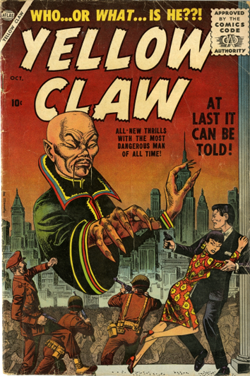 A fascinating new exhibition at NYU explores how representations of Asians in comicbooks from 1942-1986 can be grouped into eight archetypes: the Alien, the Brute, the Lotus Blossom, the Guru, the Brain, the Kamikaze, the Temptress and the Manipulator.
A fascinating new exhibition at NYU explores how representations of Asians in comicbooks from 1942-1986 can be grouped into eight archetypes: the Alien, the Brute, the Lotus Blossom, the Guru, the Brain, the Kamikaze, the Temptress and the Manipulator.
Cultural studies scholar and author, William F. Wu, offered his personal comic collection as the basis for the exhibition, which purports to show “how images that began as racist and xenophobic propaganda during times of war and nativist unrest have coalesced into archetypes that in many ways still define America’s perception of Asians today” (Exhibition Guide). Asians working within the comicbook industry have been invited to comment on how the images and narratives affected them, growing up, and their general perceptions of Asian identity.
The co-curator, Jeff Yang, describes the exhibition as
“more than just a comics collection; it’s a historical document and one that covers a period of history that in some respects can be considered to be during the specific period in which the Asian-American identity was forged.
“All of the key elements and factors that shaped who we are as a people occurred during this time – Pearl Harbor, internment, the Korean War, the Vietnam War, the rise of immigration, the building of ethnic enclaves, the beginning of the Asian-American rights movement, the rise of Japan and later China. What (Wu) did was collect images shaped by political forces, and to tell this story is to tell a narrative of how America has viewed Asians.”
America has long had a collective anxiety about Asians as ‘the Other’, from the Chinese immigrants forced into hard labor and ghettos in the 19th century to the current political drumbeats about the ‘menace’ of China’s economic rise. These comic book archetypes have both shaped and been influenced by that anxiety. This kind of stilted, repetitive representation does all kinds of damage, especially as comics are read predominantly by children. Non-Asian readers, usually without much or any exposure to actual Asian Americans, conclude that this is what all Asians are like. Asian readers absorb the images, which are usually negative, as part of their identity.
Greg Pak, a writer for Marvel Comics, says this in his exhibition sidebar:
“I just want (Asian-American characters) to be human. Because humans are flawed and crazy and capable of amazing acts of heroism and terrible acts of villainy I wouldn’t get hung up about seeing Asian tyrants or gangsters or femme fatales or martial artists if they were all different and individual and human. What I get angry about is that there are a million ways to write an Asian martial artist, so why is it that we keep on seeing the same darned one?”
Daniel Kim, co-curator, says
“As I was working on this exhibition, I came to the fascinating and horrifying realization that I had read a lot of these comics as a kid, and had either not noticed or minimized the way in which Asian characters were portrayed… That’s how pop culture works. You’re caught up in the entertainment and the pleasure of it. When I think back to my 8-year-old self, I retroactively worry for him. I wonder what this will do to him, what role it will play in developing my self-identity and the identity of all Asian boys who grew up reading comic books in America.”
Asia In American Eyes – China Daily
MARVELS AND MONSTERS: Unmasking Asian Images in U.S. Comics, 1942-1986 – NYU Fales Library, until August 19